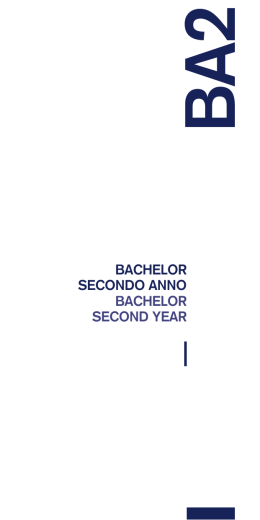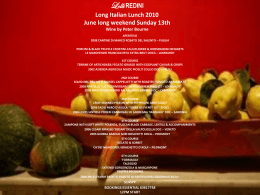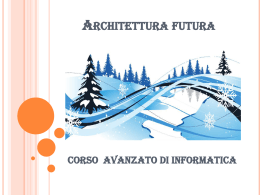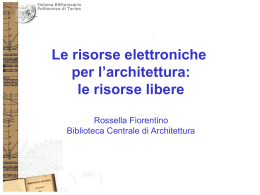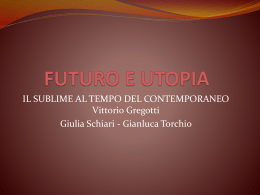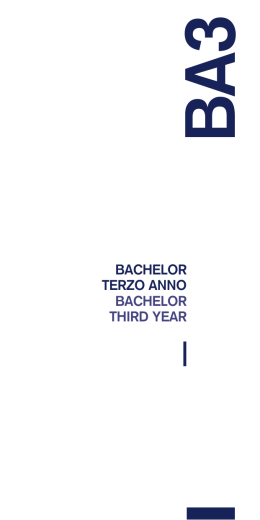BA1 BACHELOR PRIMO ANNO BACHELOR FIRST YEAR Per il superamento di ogni anno del Bachelor sono richiesti almeno 30 ECTS in Progettazione, 15 nelle materie storico-umanistiche e 15 nelle materie tecnico-scientifiche, con una media ponderata di tutte le materie del 6. Il Regolamento della scuola prevede che per ottenere il Bachelor lo studente, superato ogni singolo anno, deve avere accumulato un totale di 180 ECTS, dei quali almeno 5 in ciascuna delle discipline così contrassegnate: SA-Storia dell’arte e dell’architettura, CT-Cultura del territorio, ST-Strutture, TE-Tecnologia, e avere superato il periodo di pratica professionale obbligatorio. To be promoted in each year of the Bachelor course students are required to attain at least 30 ECTS in design, 15 in the historical-humanistic subjects, and 15 in the technical-scientific subjects with a weighted average of 6 in all subjects. The School’s regulations establish that to obtain a Bachelor degree the student, having passed each single year, must have accumulated a total of 180 ECTS, of which at least 5 must be in each of the subjects designated as follows: HA-History of Art and Architecture, CT-Culture of the Territory, ST-Structures, TE-Technology, and have completed the compulsory period of professional practice. BA1 atelier di progettazione design studios BA1 Atelier di progettazione Mario Botta (resp.) Riccardo Blumer Roberto Briccola Gabriele Cappellato Bruno Keller ORE 208+208 IT-EN LINGUA ECTS 12 + 12 SEM I + II Introduzione al progetto architettonico 24 Il primo anno prevede quattro atelier di progettazione, ognuno diretto da un docente invitato e tutti coordinati da un professore responsabile. All’interno di un tema unico e di un’area di studio comune, i quattro atelier offrono lo stesso percorso didattico ma con approcci diversi, in relazione ai programmi particolari e alla sensibilità metodologica di ogni docente. Per tutti il tema di quest’anno è Lo spazio architettonico nel territorio contemporaneo. Il programma offre un’occasione di studio e di esercizio che, attraverso la conoscenza degli elementi primari della composizione architettonica, conduce lo studente al progetto vero e proprio. L’obiettivo è comprendere lo stretto legame tra manufatto architettonico e contesto territoriale. L’area dell’analisi di quest’anno è il Piano di Magadino. Il corso propone una lettura tesa a comprendere i principi insediativi e i concetti che stanno alla base di ogni pensiero di trasformazione del paesaggio. Il rilievo, il disegno e il modello saranno la premessa per il progetto successivo. L’atelier si propone di fornire gli strumenti adatti a sviluppare una metodologia coerente della composizione architettonica, alla scala edilizia e a quella urbana. Il quadro di riferimento generale è dato dal confronto tra luoghi pubblici, spazi collettivi, luoghi privati, spazi residenziali. Il territorio contemporaneo è l’espressione del vivere quotidiano, ma anche il deposito di tutti i sedimenti e le stratificazioni della storia e della memoria. L’architettura nasce dalle relazioni che si vogliono stabilire tra il luogo e la nuova opera che, realizzandosi, lo trasforma. BA1 Design Studio SEM IT-EN HOURS 208+208 The first-year work consists of four design studios, each directed by a guest lecturer and all coordinated by a professor in charge. Within a single theme and the common area of study, the four studios classes follow the same educational path but with different approaches in relation to particular programs and the methodological sensibility of each teacher. For all of them this year’s theme is The Architectural Space in the Contemporary Territory. The program offers opportunities for study and practical work which, through an understanding of the primary elements of architectural composition, will guide the students to the project itself. Our aim is to understand the close link between architectural work and regional context. The area of the analysis this year is the plain of Magadino. The course presents a reading aimed at understanding the principles of settlement and the concepts that underlie every thought in the transformation of the landscape. The site plan, design and model will be the premise for the next project. The studio aims to provide the tools to develop a consistent methodology of architectural composition, on the scale of the building and the urban context. The general framework is presented by the comparison between public places, public spaces, private places and residential spaces. The contemporary territory is the expression of everyday living, but also the deposit of all the sediments and layers of history and memory. Architecture arises out of the relationships that we seek to establish between the place and the new work which transforms it by being built. LANGUAGE ECTS 12 + 12 Mario Botta (resp.) Riccardo Blumer Roberto Briccola Gabriele Cappellato Bruno Keller I + II Introduction to Architectural Project 25 BA1 atelier orizzontale horizontal design studio BA1 Corso obbligatorio: Atelier orizzontale Compulsory Course: Horizontal Design Studio If you are lucky, you may find yourself one early Sunday afternoon in midsummer sitting on a bench in the portico of the Junkerngasse in Bern. The design of the wooden structure is very delicate and, painted white, it pervades the projecting plinth of the pillar on which it rests. The seat and back are very comfortable and invite you to recline decorously, letting your gaze range freely down the long enfilade of the portico. If you are even more fortunate, from a half-open window of the building opposite, also with a portico, will waft the melody of an aria from Don Giovanni accompanied on the piano. Around you there will be no movement; only the light and shadows on the facades and in the pattern on the ground they absorb your thoughts. It will not be easy to get up and go away, because for an instant you will feel you have been able to grasp the sense of the city. The work that we want to share with you students this year is a tribute to this instant. SEM IT ORE/HOURS 72 Se sarete fortunati potrà accadervi di trovarvi nel primo pomeriggio di una domenica di mezza estate seduti su di una panchetta sotto il portico della Junkerngasse di Berna. Il disegno del manufatto di legno è assai delicato e laccato in bianco come è, si compenetra nell’aggetto dello zoccolo del pilastro sul quale si appoggia. La seduta e lo schienale sono molto confortevoli ed invitano ad un dignitoso abbandono, permettendovi di lasciare scorrere lo sguardo lungo la lunghissima infilata del portico. Se sarete ancora più fortunati, da una finestra appena socchiusa del caseggiato fronteggiante, anch’esso porticato, sortirà, accompagnata da un pianoforte, la melodia di un’aria del Don Giovanni. Attorno a voi non vi sarà movimento, solo la luce e le ombre sulle facciate e nel disegno al suolo potranno occupare il vostro pensiero. Non vi sarà facile alzarvi per andare via, perché per un istante vi parrà di essere riusciti a cogliere il senso della città. Il lavoro che vogliamo condividere con voi studenti quest’anno, è un omaggio a quell’istante. LINGUA/LANG. 3.0 ECTS Annina Ruf I / II Disegno e rappresentazione Design and Representation 27 BA1 Corso obbligatorio: Atelier orizzontale Compulsory Course: Horizontal Design Studio Riccardo Blumer ORE/HOURS IT LINGUA/LANG. 3.0 ECTS SEM I / II Introduzione al processo creativo Introduction to the Creative Process 28 Il corso opera un intreccio tra alcune delle grandi tematiche dell’architettura: la perizia costruttiva attraverso la conoscenza del rapporto tra materiali e meccanica; l’uso della geometria come linguaggio d’astrazione alla base del progetto delle forme; l’osservazione della natura come luogo dove tempo, materia e fisica interagiscono nella formazione di processi organici e inorganici costituenti la morfologia della bellezza; la manifestazione dell’espressività individuale con l’ausilio di specifiche fonti letterarie e con la pubblica espressione vocale delle proprie suggestioni. L’atelier introduce alcuni elementi di quel processo che forma la capacità di distinguere e porsi in relazione con il mondo fisico e sociale, in linea con la propria scelta professionale cui la formazione tecnica dovrà sempre riferirsi. The course entwines some of the major themes of architecture: constructional expertise through a knowledge of the relations between materials and mechanics; the use of geometry as a language of abstraction underlying the design of forms; the observation of nature as a place where time, matter and physics interact in the formation of organic and inorganic processes constituting the morphology of beauty; the manifestation of individual expressiveness with the assistance of specific literary sources and the public vocal expression of one’s own suggestions. The workshop introduces some elements of that process which shapes the ability to distinguish and relate to the physical and social world, in line with one’s choice of profession to which education should always be related. BA1 discipline storico-umanistiche historical-humanistic courses BA1 Corso obbligatorio: Teoria dell’arte e dell’architettura Compulsory Course: Theory of Art and Architecture Fulvio Irace 24 + 24 ORE/HOURS IT LINGUA/LANG. 5.0 ECTS SA/HA SEM I + II Storia dell’architettura contemporanea History of Contemporary Architecture 30 Attraverso lezioni, esercitazioni e visite guidate, il corso si sofferma su alcuni nodi significativi della cultura del progetto tra XIX e XXI secolo: non un sommario viaggio nella storia dell’architettura contemporanea, ma la messa a fuoco di una serie di temi/problemi – questioni di struttura, di funzione, di estetica e di consapevolezza sociale – attraverso cui si sono costruite identità e immagini della Modernità. Il corso tratterà argomenti quali: La paura della macchina e il ricorso alla Natura; Il progetto etico come progetto estetico: l’irruzione del brutto; Organico/Tettonico; L’arte per la vita: profezia di una società estetica; La Fabbrica come Modello; La grande astrazione: neues bauen, neues wohnen; Sintassi delle arti; La corsa contro il Tempo; Europa/America; La tentazione del Totalitarismo e quella dell’Internazionalismo; Le mutazioni dell’architettura nel capitalismo del consumo; Organico/meccanico; In forma urbana; Ciò che resta; Archetipo/stereotipo; Necessità dell’Utopia; L’era dei Musei; L’architettura iconica; Il Paesaggismo; Macroarchitetture. Through lectures, exercises and guided field trips, the course will deal with certain significant nodes in the culture of the architectural project between the 19th and 21st centuries. Hence, not a sketchy overview of history but a sharp focus on a series of issues – structure, function, aesthetics and social consciousness – through which the identity and images of Modernity were constructed. The course therefore explores subjects such as: The fear of the machine and recourse to Nature; The ethical project as an aesthetic project: the incursion of ugliness; Organic/Tectonic; Art for life: the prophecy of an aesthetic society; The factory as Model; The large abstraction: neues bauen, neues wohnen; Syntax of the arts; The race against Time; Europe/ America; The temptation of Totalitarianism and Internationalism; Changes in architecture in consumer capitalism; Organic/Mechanical; In urban form; What remains; Archetype/ stereotype; Necessity of Utopia; The age of Museums; Iconic architecture; Landscapism; Macroarchitecture. BA1 Corso obbligatorio: Teoria dell’arte e dell’architettura Compulsory Course: Theory of Art and Architecture What is an artist? What is an artist today by these times of crisis when art is no more than the cultural alibi of a cannibal market? Liberalism, according to Lupa, is worse than Goebbels: it destroys culture without claiming it and turns it into spectacle for the sake of profit. Hence the strategy of resistance in which the artist becomes an activist, Zmijewski wrote, and art becomes another form of politics. The course will propose a critical study of the leading, often mythical, figures of political artists from Pasolini to our days: heroes of dissidence, from Glauber to Ai Wei Wei, prophets of subversion, from Fassbinder to Farocki, defenders of the excluded, from Rouch to Mikhailov, icons of feminism, from Arbus to Goldin, masters of radicalism, from Godard or Warhol to Lynch or Tarr, and many others, who fight the society of control predicted by Deleuze, where the worst is still to come. SEM EN ORE/HOURS 24 +24 Cos’è un artista? Cos’è un artista oggi, in questi tempi di crisi in cui l’arte non è altro che l’alibi culturale di un mercato cannibale? Il liberalismo, secondo Lupa, è peggiore di Goebbels: distrugge la cultura senza dichiararlo e la trasforma in spettacolo per amore del profitto. Da qui la strategia di resistenza che fa dell’artista un attivista, come scrive Zmijewski, e dell’arte una variante della politica. Il corso propone uno studio critico delle figure maggiori, e spesso mitiche, di artisti impegnati, da Pasolini ai nostri giorni: eroi della dissidenza, da Glauber ad Ai Wei Wei; profeti della sovversione, da Fassbinder a Farocki; difensori degli esclusi, da Rouch a Mikhailov; icone del femminismo, da Arbus a Goldin; maestri del radicalismo, da Godard o Warhol a Lynch o Tarr, e molti altri, che combattono la società di controllo predetta da Deleuze, dove il peggio deve ancora venire. LINGUA/LANG. 5.0 ECTS SA/HA Régis Michel I + II Arte contemporanea Contemporary Art 31 BA1 Corso obbligatorio: Teoria dell’arte e dell’architettura Compulsory Course: Theory of Art and Architecture Nicola Emery 24 + 24 ORE/HOURS IT LINGUA/LANG. 5.0 ECTS SEM I + II Filosofia e architettura Philosophy and Architecture 32 Il corso, costruito per temi e per problemi, affronta questioni di fondo, di particolare importanza per i futuri architetti: lo spazio come bene comune; il significato della plasticità per la sopravvivenza dell’uomo; il rapporto del progetto con il “disastro della civiltà”; il rapporto della costruzione con le preesistenze storiche e “naturali”; la tabula rasa e l’annientamento della memoria; il recupero e il riuso della città e dell’architettura “minore” a fronte del furore di una sfrenata “distruzione creatrice” di origine economica. Secondo una linea tesa fra memoria e futuro, il corso, con queste sue scansioni analitiche, metterà a fuoco lo statuto difficile dell’architettura, essenzialmente tesa fra il per sé e il per gli altri, elaborando la visione di fondo di una progettazione come cura del territorio, impegnata a sottrarsi al circolo vizioso, storicamente egemone, fra distruzione e progetto e a mantenere alta la promessa originaria dell’abitare. The course, organized by topics and problems, addresses fundamental issues of particular importance to future architects: space as a common good, the significance of plasticity to human survival; the relation between the project and the “disaster of civilization”; the relation of the building to the historical and “natural” pre-existing features; the tabula rasa and the annihilation of memory; retrieval and reuse of the city and of “minor” architecture compared to the fury of an unbridled “creative destruction” with economic origins. Drawing a line between past and future, the course, with its analytical inflections, will focus on the difficult status of architecture, essentially tensed between for oneself and for others, developing the underlying vision of a project as a cure for the territory, seeking to escape from the vicious circle, historically dominant, between destruction and project, and holding high the original promise of dwelling. BA1 Corso obbligatorio: Cultura del territorio Compulsory Course: Culture of the Territory The course gives an overview of the process of development of the European city, from late antiquity to the late nineteenth and early twentieth centuries, concentrating on those radical breaks with tradition caused by wars, earthquakes or fires, which have been crucial watersheds in the construction of the city. We propose therefore to read the history of the European city as two overlapping histories, one characterized by continuity and the other by discontinuities, and with both in constant competition. The course will also explore the issues of urban growth and decline, the changing social stratification and the ideological arguments that form the framework for these developments. Part of the course is devoted to the post-classical city in literature and theory from the Renaissance to the twentieth and twenty-first centuries. On completion of the work in the lecture hall, a field trip is planned to a European capital. SEM EN ORE/HOURS 24 + 24 Il corso traccia un quadro complessivo del processo di sviluppo della città europea, dalla tarda antichità allo snodo tra Ottocento e Novecento, soffermandosi su quelle radicali interruzioni della tradizione provocate da guerre, terremoti o incendi, che hanno costituito degli spartiacque cruciali nella costruzione della città. La storia della città europea è quindi letta come sovrapposizione di due storie, caratterizzate l’una da continuità e l’altra da discontinuità, in costante competizione. Vengono inoltre affrontate le questioni della crescita e della contrazione urbane, il mutare della stratificazione sociale e i pretesti ideologici che fanno da cornice a questi sviluppi. Parte del corso è dedicata alla città post-classica nella produzione letteraria, cinematografica e nella riflessione teorica dal Rinascimento al XX e XXI secolo. È previsto un viaggio di studio in una capitale europea. LINGUA/LANG. 5.0 ECTS CT Christoph Frank I + II Modelli della città storica Exemplars of the Historical City 33 BA1 discipline tecnico-scientifiche technical-scientific courses BA1 Corso obbligatorio: Costruzione e Tecnologia Compulsory Course: Construction and Technology The topics dealt with in the course will provide an introduction to questions concerning building materials and a presentation of the “means of production” that have been and still are used in architecture. A basic knowledge of building materials will provide the students with an instrument enabling them to reconcile the conception of the abstract architectural form of each project (for example space, function, internal development, etc.) with the physical qualities attainable through the use of the appropriate material (features of the material, surface, effect, atmosphere, etc.). The knowledge conveyed will then constitute the basis of a profound competence in the constructional analysis of architectural buildings. IT ORE/HOURS 24 Temi del corso saranno una iniziazione alla problematica relativa ai materiali da costruzione e una presentazione dei “mezzi produttivi” che hanno trovato e trovano impiego nell’architettura. Una prima conoscenza dei materiali da costruzione fornirà agli studenti uno strumento che consentirà loro di conciliare l’ideazione della forma architettonica astratta di ciascun progetto (ad esempio spazio, funzione, sviluppo interno eccetera) con le qualità fisiche realizzabili attraverso l’impiego del materiale adeguato (caratteristiche del materiale, superficie, effetto, atmosfera eccetera). Le conoscenze trasmesse, inoltre, costituiranno la base di una profonda competenza per quanto riguarda l’analisi costruttiva di edifici architettonici. LINGUA/LANG. 2.5 ECTS TE I Adolph Stiller SEM Architettura e materiali Architecture and Materials 35 BA1 Corso obbligatorio: Strutture e Scienze esatte Compulsory Course: Structure and Exact Sciences Mario Monotti 24 + 24 ORE/HOURS IT LINGUA/LANG. 5.0 ECTS ST SEM I + II Introduzione alle strutture portanti in architettura Introduction to load-bearing structures in architecture 36 Capire il funzionamento di una struttura significa individuare come i carichi vengano assorbiti e trasmessi a terra. Questa tematica è approfondita mediante un’analisi grafica del flusso dei carichi con restrizione a sollecitazioni del materiale a trazione e a compressione. Fornendo gli strumenti necessari per comprendere i principi di funzionamento delle strutture portanti, il corso ha tra gli obiettivi quello di consentire all’architetto di operare delle scelte concettuali valide, di intraprendere un dialogo con l’ingegnere e di poter riconoscere e apprezzare lo sviluppo delle strutture portanti nella storia. Understanding the functioning of a structure entails identifying how the loads are absorbed and transmitted to the ground. This topic is explored by means of graphic analysis of the flow of loads with restriction to stresses on the material by tension and compression. In supplying the instruments necessary to an understanding of the principles of functioning of load-bearing structures, the purposes of the course include enabling the architect to make valid conceptual choices, to engage in a dialogue with the engineer and be able to recognize and appreciate the development of load-bearing structures in history. BA1 Corso obbligatorio: Strutture e Scienze esatte Compulsory Course: Structure and Exact Sciences Descriptive Geometry 1 After a brief introduction to the foundations and the history of Euclidean geometry, the course will study geometrical constructions with the ruler and compass. Then will follow certain observations on the golden ratio and its applications. Finally, we will study Monge’s method of perpendicular projections on a plane. This will allow us to introduce, citing examples and special cases, the basic concepts of axonometry and perspective. Descriptive Geometry 2 The course will examine the techniques of axonometry and perspective. First we will review the various axonometric projections (military, cavalry, Eckhart’s and normal), before passing on to the study of perspective with connections to the history of art (Masaccio, Leon Battista Alberti, Piero della Francesca, Paolo Uccello). The course will be completed by the study of certain curves (conics, ovals, spirals, cycloids and their variants). IT ORE/HOURS 48 Geometria descrittiva 1 Dopo una breve introduzione ai fondamenti e alla storia della geometria euclidea, saranno studiate le costruzioni geometriche con riga e compasso. Seguiranno alcune considerazioni sul rapporto aureo e le sue applicazioni. Sarà infine studiato il metodo di Monge delle proiezioni ortogonali su un piano. Questo permetterà di introdurre, con alcuni esempi e casi particolari, i concetti di base dell’assonometria e della prospettiva. Geometria descrittiva 2 Saranno approfondite le tecniche dell’assonometria e della prospettiva. Saranno dapprima passate in rassegna le varie assonometrie (militare, cavaliera, di Eckhart, normale), per poi passare allo studio della prospettiva con collegamenti alla storia dell’arte (Masaccio, Leon Battista Alberti, Piero della Francesca, Paolo Uccello). Il corso sarà completato dallo studio di alcune curve (le coniche, gli ovali, le spirali, le cicloidi e le loro varianti). LINGUA/LANG. 5.0 ECTS I Paolo Venzi SEM Geometria descrittiva Descriptive Geometry 37 BA1 Corso obbligatorio: Strutture e Scienze esatte Compulsory Course: Structure and Exact Sciences Giovanni Battista Balestra Lidor Gilad 24 ORE/HOURS IT LINGUA/LANG. 2.5 ECTS II SEM Rappresentazione digitale 1 Digital Representation 1 38 Il corso, articolato in lezioni teoriche ed esercitazioni, si propone di sviluppare nello studente la capacità di leggere, rappresentare e progettare un oggetto mediante il corretto uso dello strumento disegno nella forma bidimensionale. Saranno trattate regole, modalità e tecniche secondo le quali è possibile costruire un modello grafico del reale nelle due dimensioni del disegno, esatto ed universalmente leggibile. Particolare attenzione sarà posta sui rapporti tra l’oggetto e lo spazio, l’ambiente con cui si relaziona, e tra l’oggetto e l’uomo, il fruitore con cui si relaziona. Gli obiettivi del corso sono rivolti all’individuazione dei metodi e degli strumenti utili per la la rappresentazione bidimensionale del progetto d’architettura. The Course, organized as lectures and practical work, aims to develop in students the ability to interpret, represent and design an object through the correct use of the instrument of drawing in two-dimensional form. It will deal with the rules, procedures and techniques which make it possible to construct a graphic model of reality in the two dimensions of the drawing so as to be accurate and universally legible. Particular attention will be devoted to the relation between the object and the space, the environment to which it is related, and between the object and people, the users, which it has to relate to. The objectives of the course are to identify the methods and instruments for the two-dimensional representation of the architectural project. BA1 Corso obbligatorio: Strutture e Scienze esatte Compulsory Course: Structure and Exact Sciences Analysis 1 After a recapitulation of the basic concepts from algebra, we will begin our approach by introducing the concept of infinite succession. This will be followed by a recapitulation of the main elementary functions (polynomials, rational functions, trigonometrics, exponentials) and their applications. We will then pass to the elementary notion of function and the comprehensive study of functions. The concept of limit will then lead us to the definition of the continuity of a function and to the study of its properties. Analysis 2 We will begin by introducing the concept of the derivative of a function: its properties, the technique of calculus, its applications (for example the study of maximums and minimums). Subsequently we will examine the chapter on integrals and their applications (calculation of areas, volumes, surfaces, lengths of arches, centre of mass). IT ORE/HOURS 48 Analisi 1 Dopo un riepilogo delle nozioni di base dall’algebra inizieremo il percorso introducendo il concetto di successione infinita. Seguirà un riepilogo delle principali funzioni elementari (polinomi, razionali, trigonometriche, esponenziali) e delle loro applicazioni. Passeremo poi alla nozione di funzione elementare e allo studio globale delle funzioni. Il concetto di limite ci porterà quindi alla definizione della continuità di una funzione e allo studio delle sue proprietà. Analisi 2 Inizieremo introducendo il concetto di derivata di una funzione: le sue proprietà, la tecnica di calcolo, le sue applicazioni (per esempio lo studio dei massimi e dei minimi). Di seguito affronteremo il capitolo sugli integrali e le loro applicazioni (calcolo di aree, volumi, superfici, lunghezze di archi, centri di massa). LINGUA/LANG. 5.0 ECTS II Paolo Venzi SEM Analisi matematica Mathematical Analysis 39
Scarica
